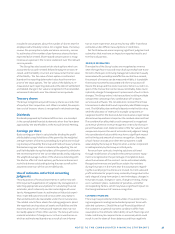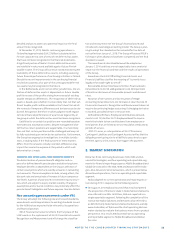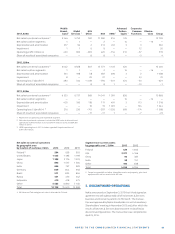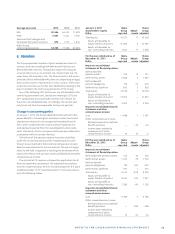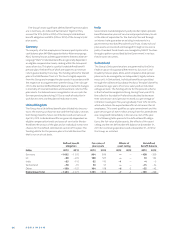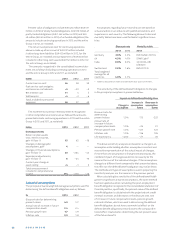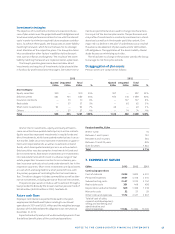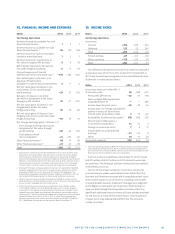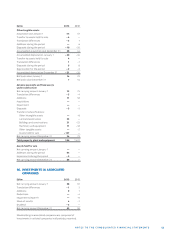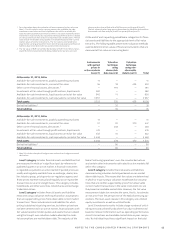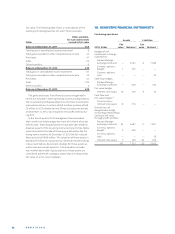Nokia 2013 Annual Report Download - page 49
Download and view the complete annual report
Please find page 49 of the 2013 Nokia annual report below. You can navigate through the pages in the report by either clicking on the pages listed below, or by using the keyword search tool below to find specific information within the annual report.
47
NOTES TO THE CONSOLIDATED FINANCIAL STATEMENTS
Investment strategies
The objective of investment activities is to maximize the ex-
cess of plan assets over the projected benefi t obligations and
to achieve asset performance at least in line with the interest
costs in order to minimize required future employer contribu-
tions. To achieve these goals, the Group uses an asset-liability
matching framework, which forms the basis for its strategic
asset allocation of the respective plans. The Group also takes
into consideration other factors in addition to the discount
rate, such as infl ation and longevity. The results of the asset-
liability matching framework are implemented on a plan level.
The Group’s pension governance does not allow direct
investments and requires all investments to be placed either
in funds or by professional asset managers. Derivative instru-
ments are permitted and are used to change risk characteris-
tics as part of the German plan assets. The performance and
risk profi le of investments is constantly monitored on a stand-
alone basis as well as in the broader portfolio context. One
major risk is a decline in the plan`s funded status as a result of
the adverse development of plan assets and/or defi ned ben-
efi t obligations. The application of the Asset-Liability-Model
study focuses on minimizing such risks.
There has been no change in the process used by the Group
to manage its risk from prior periods.
Disaggregation of plan assets
Pension assets are comprised as follows:
2013 2012
Quoted Unquoted Total Quoted Unquoted Total
EURm EURm EURm % EURm EURm EURm %
Asset category
Equity securities 300 — 300 24% 397 — 397 22%
Debt securities 564 121 685 54% 973 116 1089 60%
Insurance contracts — 70 70 6% — 137 137 8%
Real estate — 57 57 5% — 62 62 3%
Short-term investments 92 — 92 7% 49 — 49 3%
Others — 57 57 4% — 74 74 4%
Total 956 305 1261 100% 1419 389 1 808 100%
All short term investments, equity and nearly all fi xed in-
come securities have quoted market prices in active markets.
Equity securities represent investments in equity funds and
direct investments, which have quoted market prices in an ac-
tive market. Debt securities represent investments in govern-
ment and corporate bonds, as well as investments in bond
funds, which have quoted market prices in an active market.
Debt securities may also comprise investments in funds and
direct investments. Real estate investments are investments
into real estate funds which invest in a diverse range of real
estate properties. Insurance contracts are customary pen-
sion insurance contracts structured under domestic law in the
respective countries. Short-term investments are liquid assets
or cash which are being held for a short period of time, with
the primary purpose of controlling the tactical asset alloca-
tion. The other category includes commodities as well as alter-
native investments, including derivative fi nancial instruments.
The pension plan assets include a self investment through a
loan provided to Nokia by the Group’s German pension fund of
EUR million (EUR million in ). See Note .
Future cash fl ows
Employer contributions expected to be paid to the post-
employment defi ned benefi t plans relating to continued
operations in are EUR million and the weighted average
duration of the defi ned benefi t obligations was . years at
December , .
Expected maturity analysis of undiscounted payments from
the defi ned benefi t plans of the continued operations:
Pension benefi ts, EURm
Within1year 34
Between1 and5years 150
Between5 and10years 264
Between10 and20years 826
Over20years 1 840
Total 3114
7. EXPENSES BY NATURE
EURm 2013 2012 2011
Continuing operations
Cost of material 2 835 3 820 4 201
Personnel expenses 3 857 4 108 4 510
Subcontracting costs 2 427 3 070 2 742
Real estate costs 351 446 408
Depreciation and amortization 560 1 088 1 318
Warranty costs 52 21 59
Other costs and expenses 1 572 2 431 2 847
Total of cost of sales,
research and development,
selling and marketing and
administrative and
general expenses 11654 14984 16085


